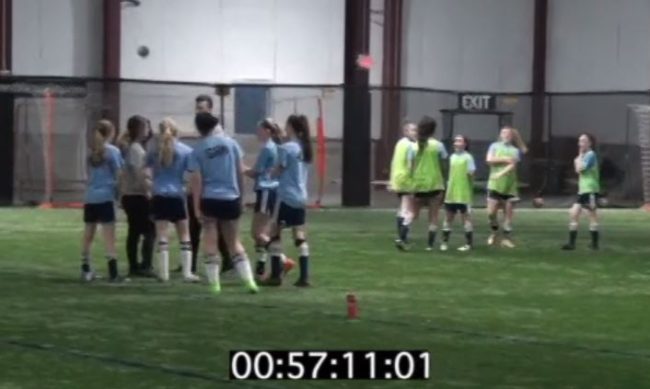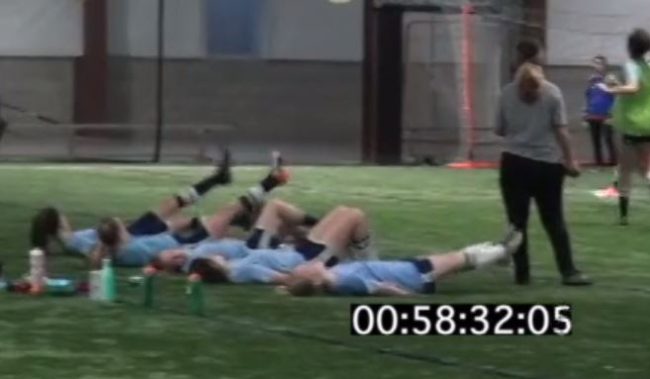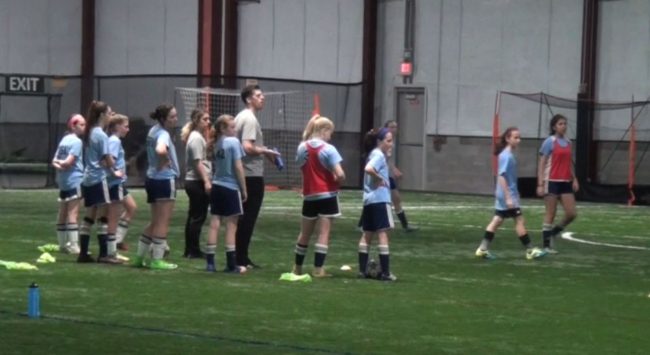06.23.17For Coaches: Making Downtime More Productive During Practice
Recently I watched Mike Ellicott training his U13 girls at Empire United‘s development academy in Rochester. I wanted to share an idea that came out of it.
When his girls broke into three groups for small sided games–one group ‘off’ while the other two played; the third group rotating in after five mins–something caught my eye. Mike gave the girls in the third group cards.

Giving out “the cards”
He said “We’ll be using the cards again” and the girls laughed. The purpose of the cards soon became clear. They were workout cards. While they were ‘out’ the girls did a series of fitness activities–one minute on one minute off, each time drawing a new card–instead of just standing and waiting. It struck me as a very clever solution to one of training’s constant challenges: What to do to maximize value when not everyone can be on the field or court at once.

“One minute on; one minute off”
But then Mike and I started batting around some other ideas. For example, earlier in his practice he had done some more tactical work. This involved about 7 girls watching while others played and Mike taught (see picture below).

During the tactical drill.
What about the girls who were watching? Could we adapt Mike’s idea of the cards to engage them mentally and while they were “off.” We talked about trying “observation cards” with the girls getting a card with something specific to look for. “Watch and try to evaluate everyone’s first touch.” or “Observe and assess the movement off the ball.” Then when he stopped for coaching pints he could even call on girls. “OK, who was watching for first touch? How did Ava do there?” Not only would this engage them in watching more intentionally it would teach them to watch the game technically.
This is something I think about a lot with my own kids. Watching at home I will be watching deliberately for first touches or the spacing of the back four. Often if it’s teams I don’t have a strong feeling for–i watch that more than the game. And sometimes I’ll say to my kids. “Wow, did you see how he re-directed his first touch there?” because i will have found it to be like a revelation. But of course the answer is no: they did not see his first touch. They were watching the game. They were not watching technically. All of which is fine in our living room on Saturday, I guess. But think of how much value we could create if we taught our players to watch the game better. “Observation cards” could help accelerate that process.
Anyway as Mike and I were batting this idea around he took it even a couple of steps further. 1) You could individualize the cards. Give kids a player at their position to watch. Or give them a skill they are struggling with to watch for. Margaret, whose first touch is often static, gets the “watch the first touch” card or even the “watch to see whether and how players change direction with their first touch. be ready to share excellent examples.” 2) You could even be transparent about it. “I’m giving you this card because it’s the next step for you to take your game up a level. Watch carefully and learn!”
Anyway I thought it was a good idea- not just to make practices more productive physically and intellectually but to teach players to watch better and technically on their own. Thanks for Mike for sharing it. Hope coaches out there are able to steal and adapt it even more.

Love the cards idea with the young guys Mike….teaching observational skills as well as engaging them (“fond” memories of 11 year olds running amok as they waited in a Gaelic football drill ). Thanks for sharing.
Getting the most from time is also a major focus for coaching in pro sport. As well as priming those resting/watching to observe for learning and engagement purposes, observational priming can also be a powerful empowerment tool. For example, when there are 8 guys working the scrum machine (rugby coach now) I might ask Jack, “Jack, do me a favour and keep an eye on Joe’s foot position, let me know if he’s …… and give him feedback.” Not only is Jack working his conceptualisation of a technique he will perform shortly but I sense that Jack feels trusted and empowered as he is asked to do “a coaching job”. It immediately places value on his knowledge and his ability to contribute to the team cause.
There are many other great fallouts from this kind of peer observation and feedback process, the earlier kids can start the more likely they are to engage deeply in training and develop their relationship with the feedback process.
Thanks for your insights, Dan. Spoke to a Rugby coach at a professional team in NZ about this last week. When they play, they do so in groups of three. Two teams on one watching. They run live footage of practice back to a monitor where one of the coaches sits with the third team and analyze the video in a similar way- you watch for a specific topic or your watch your position pair, etc. But they–like you–are very focused on developing players’ ‘eyes.’